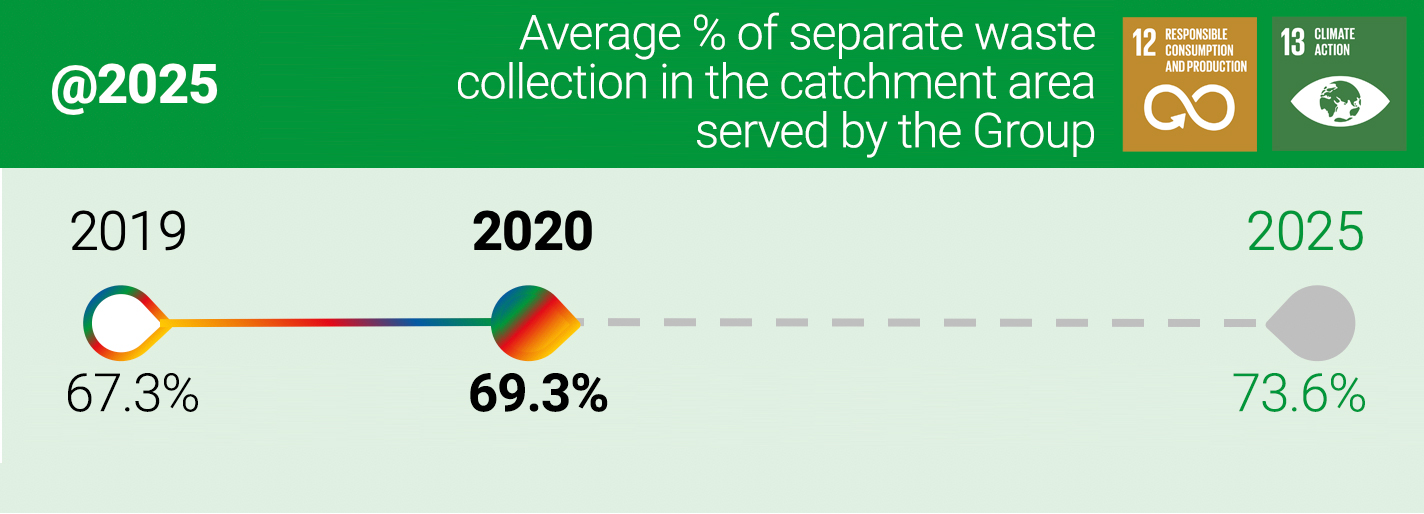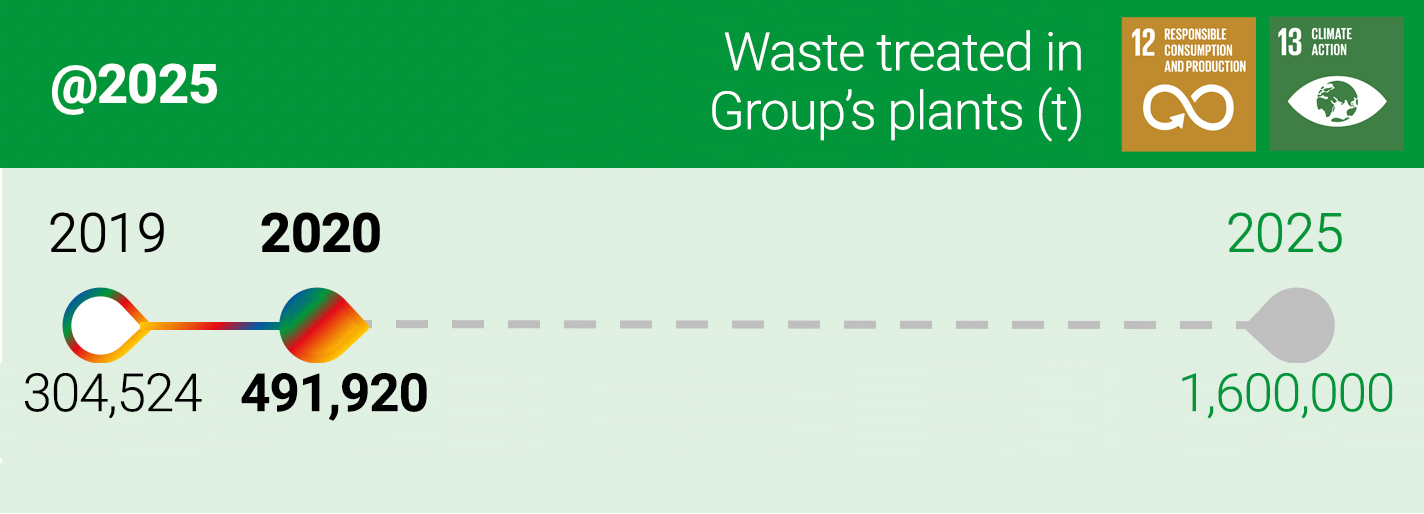Waste collection
Iren Group operates in the waste collection sector in a number of different capacities, depending on the agreements in place with service providers:
- as an operator, based on long-term service contracts, in 166 municipalities in the provinces of La Spezia (Acam Ambiente), Parma, Piacenza, Reggio Emilia (Iren Ambiente), Vercelli (ASM Vercelli) and in the city of Turin (Amiat). In these contexts, the Group collaborates with the Regulatory Bodies to define targets and plan the collection systems;
- as a contractor, in the case of San Germano, with operational support to local authorities or other operators, in 141 other municipalities.
In 2020, the Group provided urban waste collection services in a catchment area of more than 3 million residents, where the Group handled almost 2.2 million tons of urban waste (approximately 325,900 tons collected by San Germano).
The Covid-19 emergency has required the Group to reorganise the collection service by adopting specific methods, in line with the provisions of the local authorities: in Liguria, a dedicated collection of waste produced by households where there were cases of contagion or quarantine has been set up; in Piedmont and Emilia-Romagna, on the other hand, in the presence of cases of infection or quarantine, the sorting of waste has been suspended, to send it all for disposal by waste-to-energy, which is considered the most suitable method for guaranteeing health and safety.
Preventing waste generation, increasing sorted waste collection levels, and recycling waste are critical objectives of waste management policies, as they reduce disposal requirements and thus the overall environmental impact. In addition to specific communication and information campaigns aimed at raising awareness among citizens to reduce waste production, Iren Group adopts advanced collection systems (door-to-door, ecostation with user recognition), which contribute to achieving high levels of sorted waste collection: in 2020, the Group reached 69.3% of sorted waste collection (67.3% in 2019), compared to a national average of 61.3%, once again exceeding the target of 65% by 2035 of the European Union’s Circular Economy package.
In the system offered to residents to increase the results of sorted waste collection, the presence of 195 Waste Collection Centres (of which 32 in the San Germano operation area) is particularly relevant, enabling residents to freely deposit waste in large containers. The range of services is completed by collecting bulky waste at home and services dedicated to companies for the management of waste assimilated to urban waste.
Of the 1,335,891 tons of urban waste collected in the areas where the Group acts as operator, 922,933 tons referred to sorted waste. The municipalities served by San Germano also achieved positive results with around 217,555 tons of sorted waste collected.
Sorted waste collection by region (%)

The percentages of sorted waste collection achieved in 2020 show a very positive trend: in Parma and Reggio Emilia, the results exceed 80%, and in the city of Turin, they go beyond 50%.
The Group has planned investments to bring all the regions to excellence: the Business Plan sets the objective of further growth in the sorted waste collection (73.6% by 2025 and approximately 80% by 2035).

Sorted waste collection by method (t)

In 2020, sorted waste collection, which will be 1% less than in 2019 due to the already highlighted suspension of sorted waste collection due to cases of quarantine or Covid-19 infection, is sent for recovery through specialised platforms and sector supply chains, thanks to the agreements in place with the Consortia belonging to Conai (National Packaging Consortium), or through private operators.
Sorted waste recovered by type

Waste recovery, treatment and disposal
In order to guarantee an effective management of the entire cycle, the Group is also committed to the treatment and disposal of waste, the recovery of material and the exploitation of the resource waste for the generation of electricity, heat and biogas through a structured system of plants.
The plants owned by Iren Group are summarised in the table:
| Plants | Number |
| Waste-to-energy plants | 3 |
| Operating landfills | 2 |
| Storage and transfer | 18 |
| Liquid waste treatment | 4 |
| Material recovery | 13 |
| Organic waste treatment and recovery | 3 |
| Mechanical-biological treatment with SSF production | 1 |
In 2020, a total of 2.9 million tons of waste was managed, including 328,794 tons collected by San Germano (these quantities are not included in the breakdowns below).
Waste managed by area (%)

Waste managed by type (t)

The sorted component of the waste can be sent directly for recovery or transit through Group plants or storage areas, where it is sorted and/or treated before its final destination.
The unsorted component of the waste collected is destined for various disposal methods searching for the best use of the waste resource that sees energy recovery, through waste-to-energy, as the most effective solution from an environmental point of view. The Group has structured some plants for the preventive mechanical sorting process with the goal of intercepting a wet fraction of waste that is rich in organic material and which can be stabilised biologically.
Destination of managed waste (%)

49% of the waste managed by the Group in 2020 was destined for the material recovery chain in Group and third-party plants.
Waste sent for material recovery (%) (1)

(1) Approximately 2,640 tons consist of hazardous waste, equal to 0.2% of the total.
66% of the portion of the waste that could not be recovered as a material was sent for energy recovery, and the remainder – representing 17.7% of the total waste managed – for disposal.
Waste disposed (%) (1)

(1) Approximately 37,970 tons consist of hazardous waste, equal to 3% of the total. No waste has been sent for incineration without energy recovery.
In its Business Plan to 2025, the Group has demonstrated its growing commitment to closing the circular economy cycle, conceiving investments in several new plants for the recovery of the organic fraction, with the production of compost and biomethane, for the recovery of paper, plastic and wood, with the production of materials that are reintroduced onto the market.
I.Blu, through its plants in Costa di Rovigo and in San Giorgio di Nogaro (UD) (expected to be operational by 2021), transforms mixed plastics deriving from the sorted waste collection into Blupolymer® and the secondary reducing agent Bluair®: the former consists of a recycled plastic granule with multiple uses, such as the construction of buildings and resistant infrastructures, containers and bags for sorted waste collection and many other objects; the latter is a techno-polymer designed for the steel industry, which acts as a reducing agent, replacing fossil fuel and significantly improving efficiency and environmental impact.
One of the Group’s primary medium and long-term objectives is to increase waste recovery capacity in its own plants: this is expected to reach 1.6 million tons in 2025 and around 2 million tons in 2035. In 2020, thanks to the acquisition of the I.Blu plants and the complete consolidation of the operations that took place during 2019 (CMT and Ferrania Ecologia), the amount of waste treated in Group plants increased by 62% compared to 2019.

2020 was also the year of the launch of Just Iren, a digitalisation project that will make the management of waste collection services increasingly efficient. The project started in the City of Turin and will be progressively extended to all the other areas.





